TOYOTA YARIS 2014 Owners Manual
Manufacturer: TOYOTA, Model Year: 2014, Model line: YARIS, Model: TOYOTA YARIS 2014Pages: 712, PDF Size: 30.2 MB
Page 601 of 712
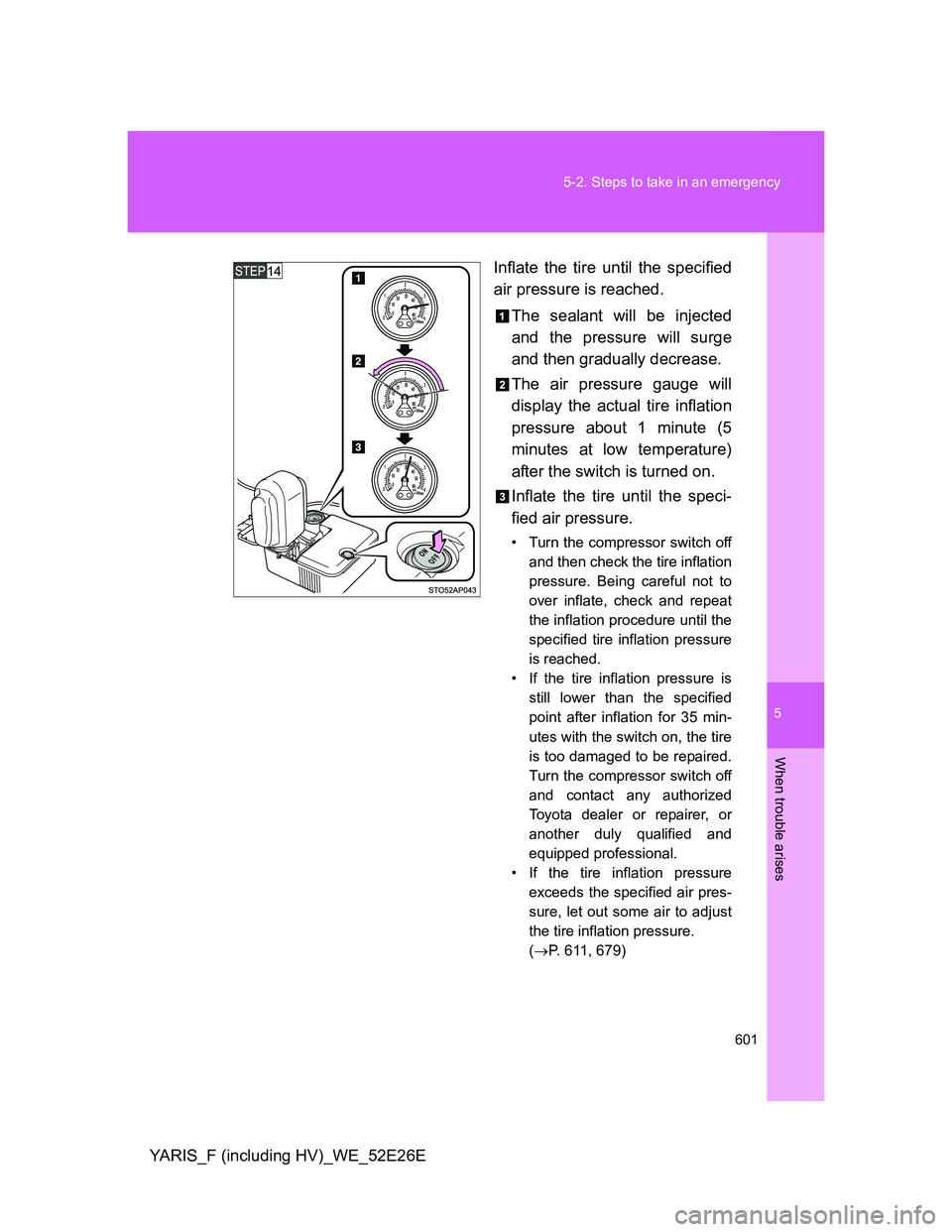
5
601 5-2. Steps to take in an emergency
When trouble arises
YARIS_F (including HV)_WE_52E26EInflate the tire until the specified
air pressure is reached.
The sealant will be injected
and the pressure will surge
and then gradually decrease.
The air pressure gauge will
display the actual tire inflation
pressure about 1 minute (5
minutes at low temperature)
after the switch is turned on.
Inflate the tire until the speci-
fied air pressure.
• Turn the compressor switch off
and then check the tire inflation
pressure. Being careful not to
over inflate, check and repeat
the inflation procedure until the
specified tire inflation pressure
is reached.
• If the tire inflation pressure is
still lower than the specified
point after inflation for 35 min-
utes with the switch on, the tire
is too damaged to be repaired.
Turn the compressor switch off
and contact any authorized
Toyota dealer or repairer, or
another duly qualified and
equipped professional.
• If the tire inflation pressure
exceeds the specified air pres-
sure, let out some air to adjust
the tire inflation pressure.
(P. 611, 679)
Page 602 of 712
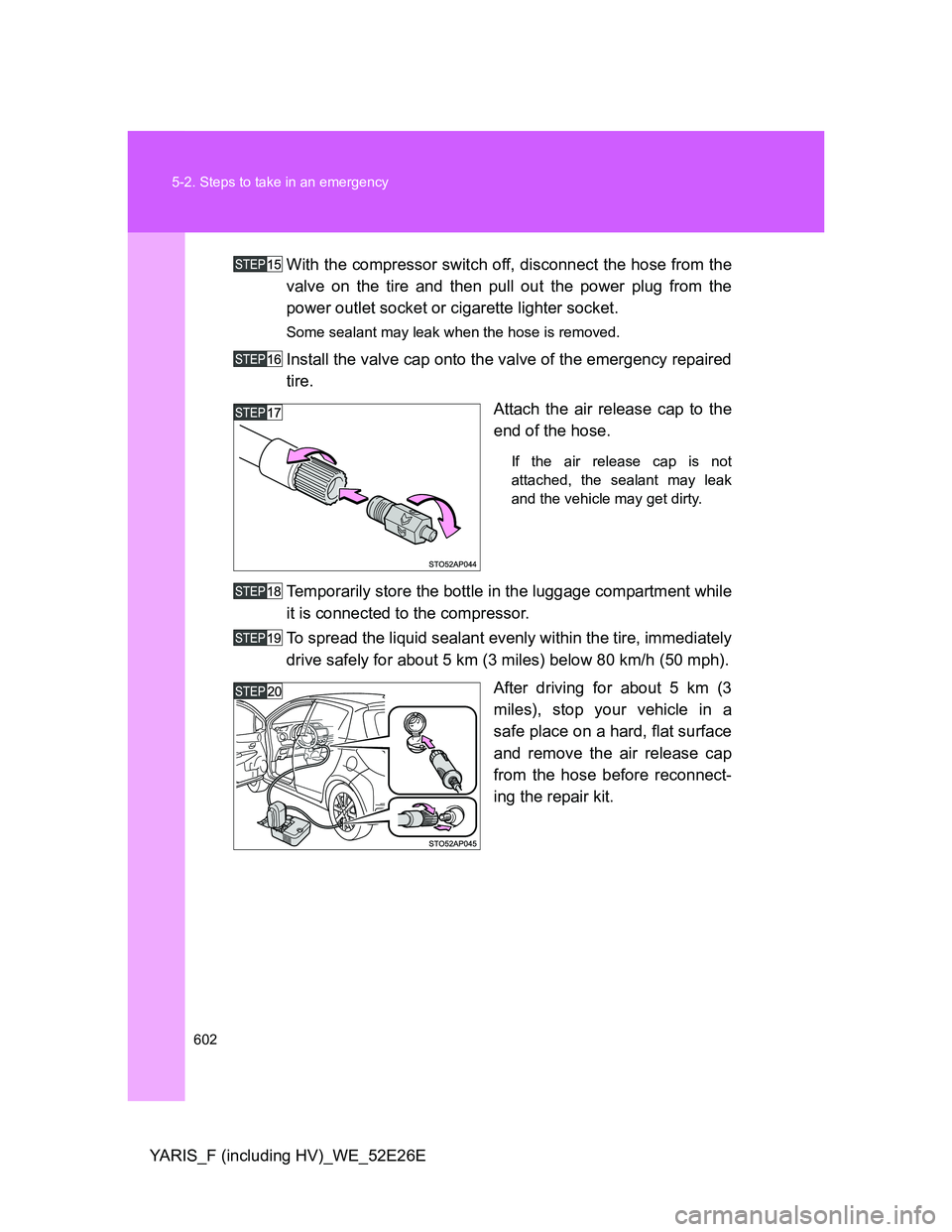
602 5-2. Steps to take in an emergency
YARIS_F (including HV)_WE_52E26EWith the compressor switch off, disconnect the hose from the
valve on the tire and then pull out the power plug from the
power outlet socket or cigarette lighter socket.
Some sealant may leak when the hose is removed.
Install the valve cap onto the valve of the emergency repaired
tire.
Attach the air release cap to the
end of the hose.
If the air release cap is not
attached, the sealant may leak
and the vehicle may get dirty.
Temporarily store the bottle in the luggage compartment while
it is connected to the compressor.
To spread the liquid sealant evenly within the tire, immediately
drive safely for about 5 km (3 miles) below 80 km/h (50 mph).
After driving for about 5 km (3
miles), stop your vehicle in a
safe place on a hard, flat surface
and remove the air release cap
from the hose before reconnect-
ing the repair kit.
Page 603 of 712
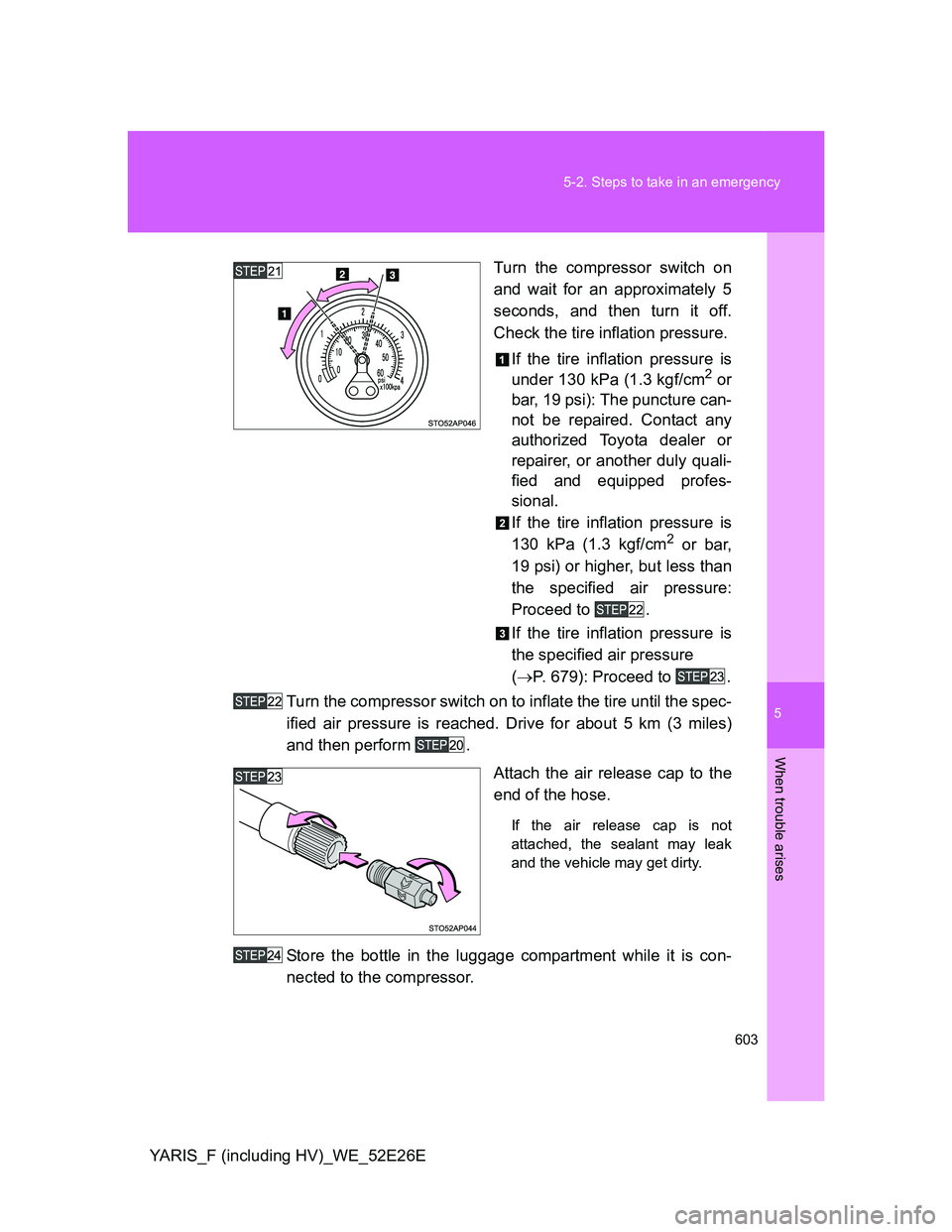
5
603 5-2. Steps to take in an emergency
When trouble arises
YARIS_F (including HV)_WE_52E26ETurn the compressor switch on
and wait for an approximately 5
seconds, and then turn it off.
Check the tire inflation pressure.
If the tire inflation pressure is
under 130 kPa (1.3 kgf/cm
2 or
bar, 19 psi): The puncture can-
not be repaired. Contact any
authorized Toyota dealer or
repairer, or another duly quali-
fied and equipped profes-
sional.
If the tire inflation pressure is
130 kPa (1.3 kgf/cm
2 or bar,
19 psi) or higher, but less than
the specified air pressure:
Proceed to .
If the tire inflation pressure is
the specified air pressure
(P. 679): Proceed to .
Turn the compressor switch on to inflate the tire until the spec-
ified air pressure is reached. Drive for about 5 km (3 miles)
and then perform .
Attach the air release cap to the
end of the hose.
If the air release cap is not
attached, the sealant may leak
and the vehicle may get dirty.
Store the bottle in the luggage compartment while it is con-
nected to the compressor.
Page 604 of 712
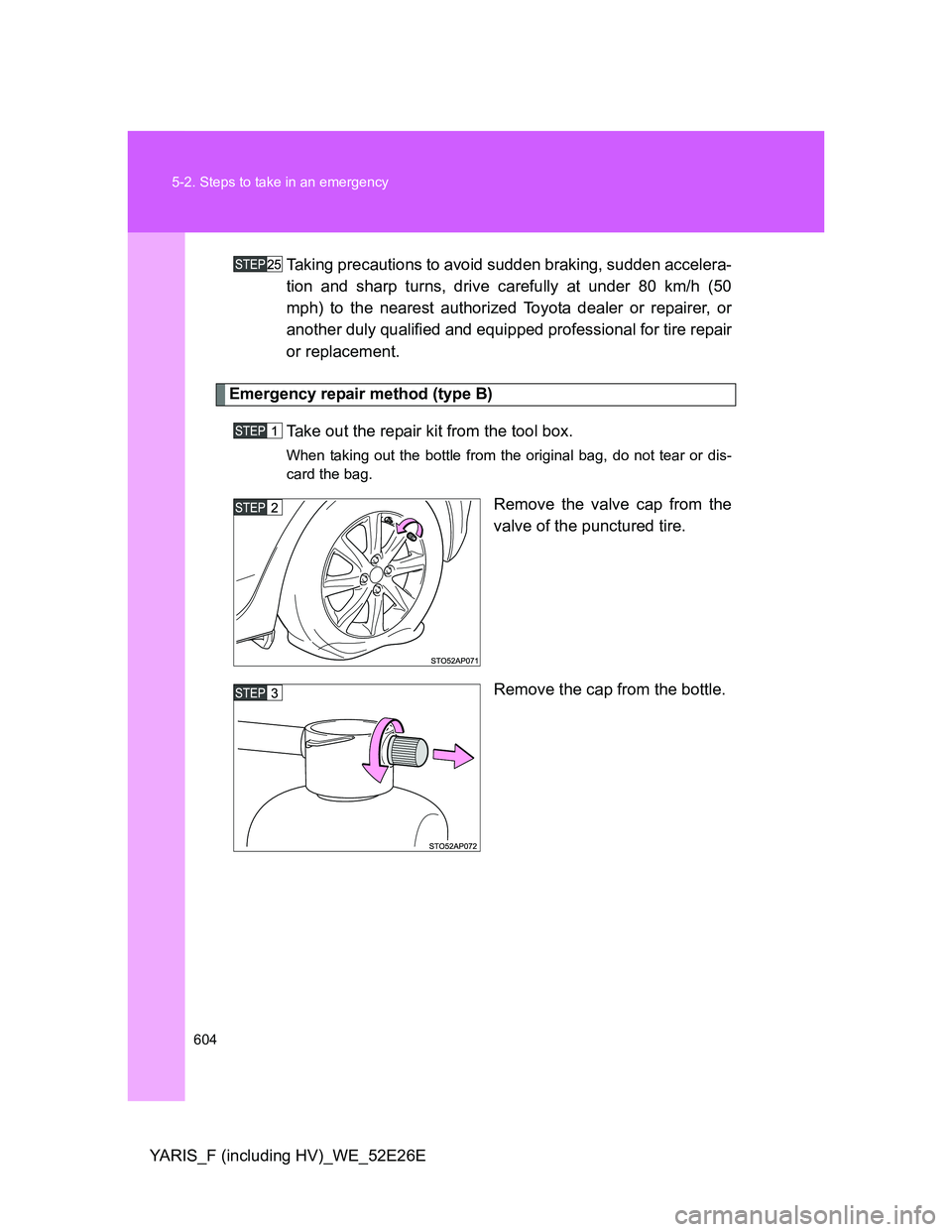
604 5-2. Steps to take in an emergency
YARIS_F (including HV)_WE_52E26ETaking precautions to avoid sudden braking, sudden accelera-
tion and sharp turns, drive carefully at under 80 km/h (50
mph) to the nearest authorized Toyota dealer or repairer, or
another duly qualified and equipped professional for tire repair
or replacement.
Emergency repair method (type B)
Take out the repair kit from the tool box.
When taking out the bottle from the original bag, do not tear or dis-
card the bag.
Remove the valve cap from the
valve of the punctured tire.
Remove the cap from the bottle.
Page 605 of 712
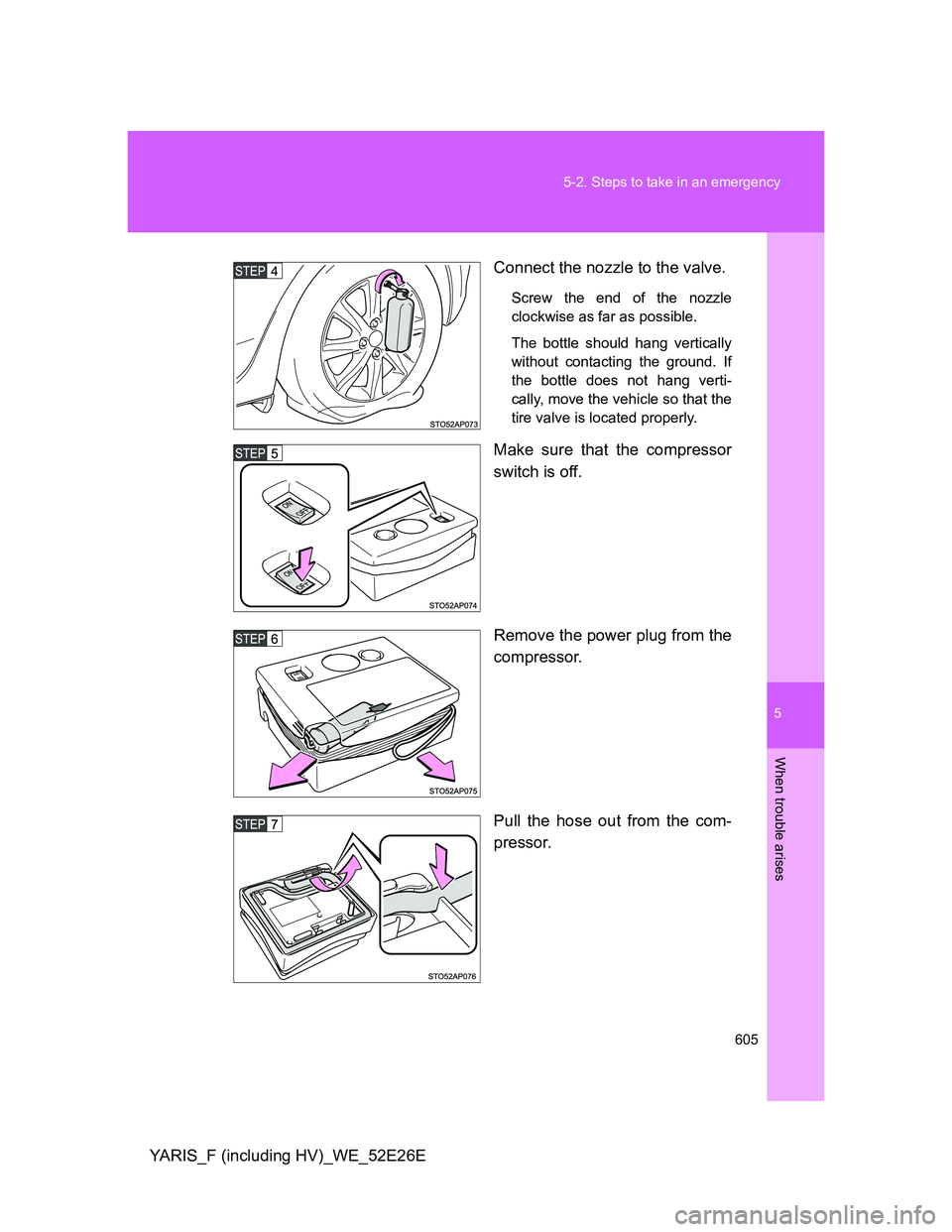
5
605 5-2. Steps to take in an emergency
When trouble arises
YARIS_F (including HV)_WE_52E26EConnect the nozzle to the valve.
Screw the end of the nozzle
clockwise as far as possible.
The bottle should hang vertically
without contacting the ground. If
the bottle does not hang verti-
cally, move the vehicle so that the
tire valve is located properly.
Make sure that the compressor
switch is off.
Remove the power plug from the
compressor.
Pull the hose out from the com-
pressor.
Page 606 of 712
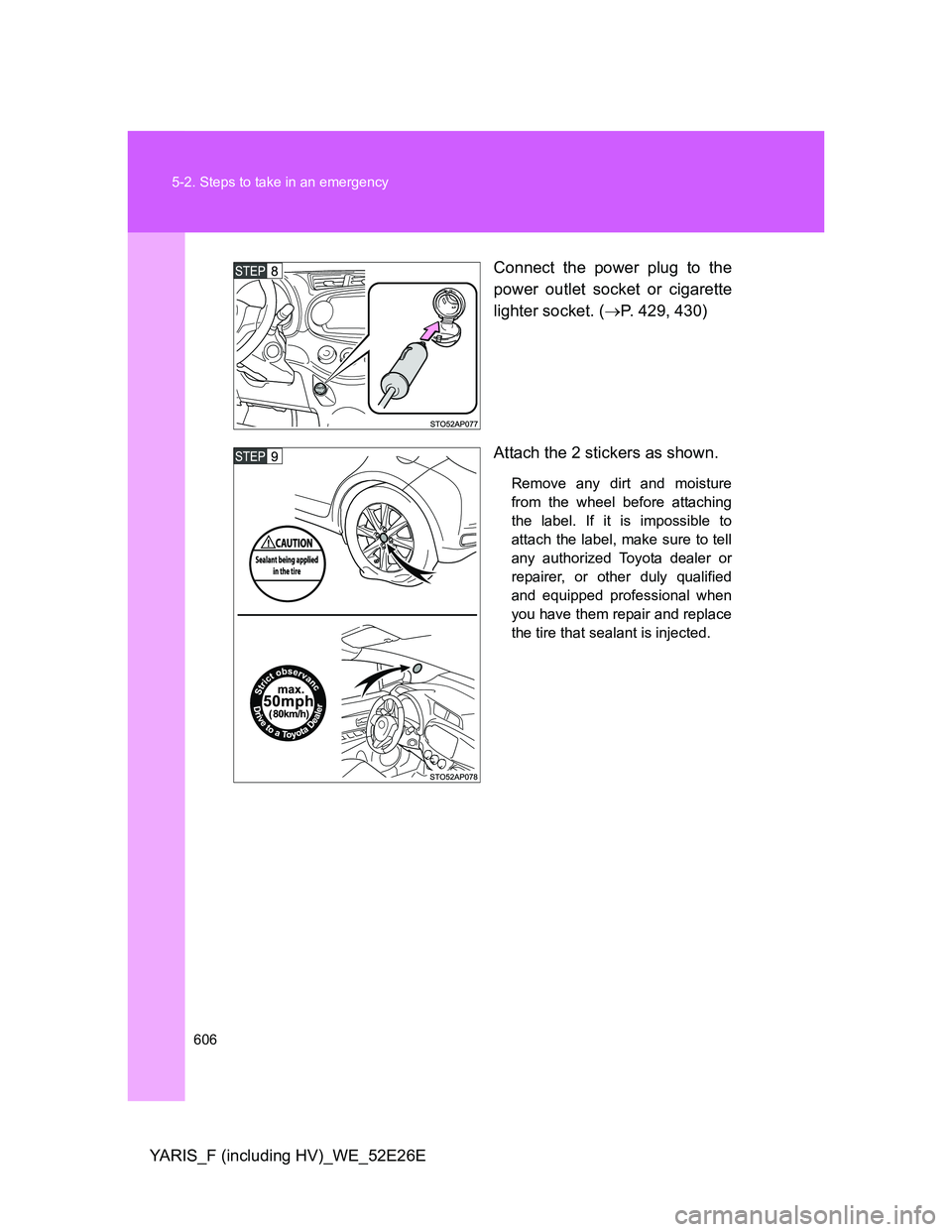
606 5-2. Steps to take in an emergency
YARIS_F (including HV)_WE_52E26EConnect the power plug to the
power outlet socket or cigarette
lighter socket. (P. 429, 430)
Attach the 2 stickers as shown.
Remove any dirt and moisture
from the wheel before attaching
the label. If it is impossible to
attach the label, make sure to tell
any authorized Toyota dealer or
repairer, or other duly qualified
and equipped professional when
you have them repair and replace
the tire that sealant is injected.
Page 607 of 712
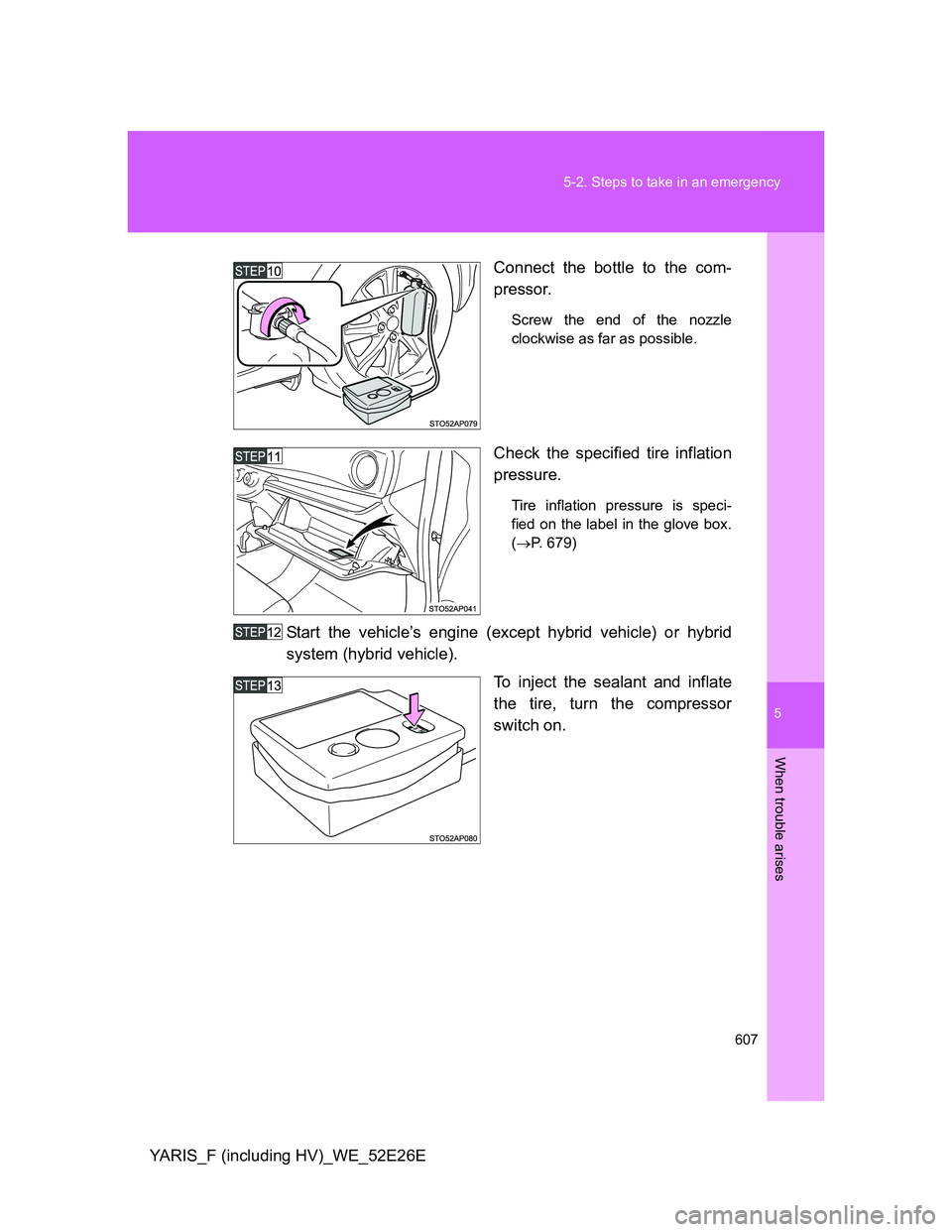
5
607 5-2. Steps to take in an emergency
When trouble arises
YARIS_F (including HV)_WE_52E26EConnect the bottle to the com-
pressor.
Screw the end of the nozzle
clockwise as far as possible.
Check the specified tire inflation
pressure.
Tire inflation pressure is speci-
fied on the label in the glove box.
(P. 679)
Start the vehicle’s engine (except hybrid vehicle) or hybrid
system (hybrid vehicle).
To inject the sealant and inflate
the tire, turn the compressor
switch on.
Page 608 of 712
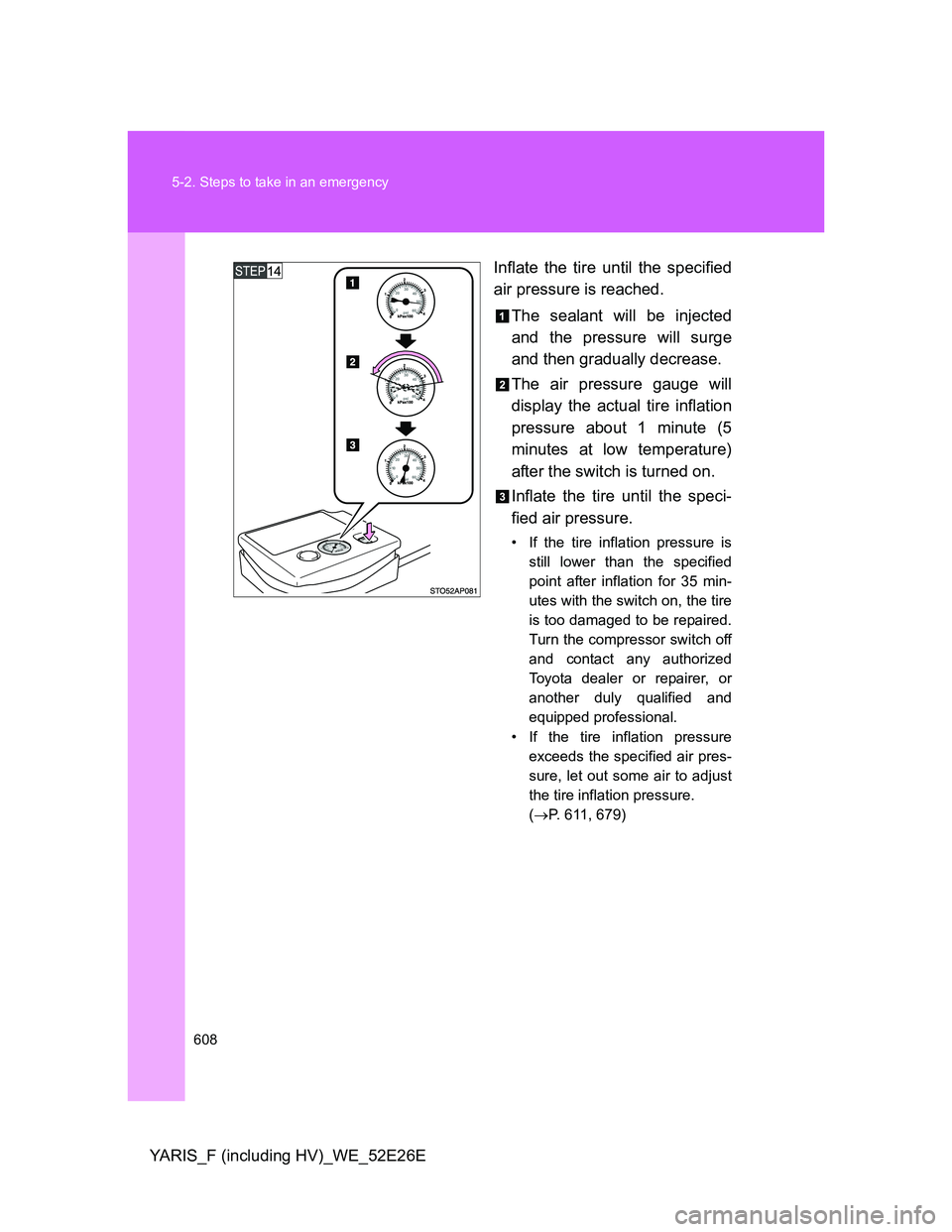
608 5-2. Steps to take in an emergency
YARIS_F (including HV)_WE_52E26EInflate the tire until the specified
air pressure is reached.
The sealant will be injected
and the pressure will surge
and then gradually decrease.
The air pressure gauge will
display the actual tire inflation
pressure about 1 minute (5
minutes at low temperature)
after the switch is turned on.
Inflate the tire until the speci-
fied air pressure.
• If the tire inflation pressure is
still lower than the specified
point after inflation for 35 min-
utes with the switch on, the tire
is too damaged to be repaired.
Turn the compressor switch off
and contact any authorized
Toyota dealer or repairer, or
another duly qualified and
equipped professional.
• If the tire inflation pressure
exceeds the specified air pres-
sure, let out some air to adjust
the tire inflation pressure.
(P. 611, 679)
Page 609 of 712
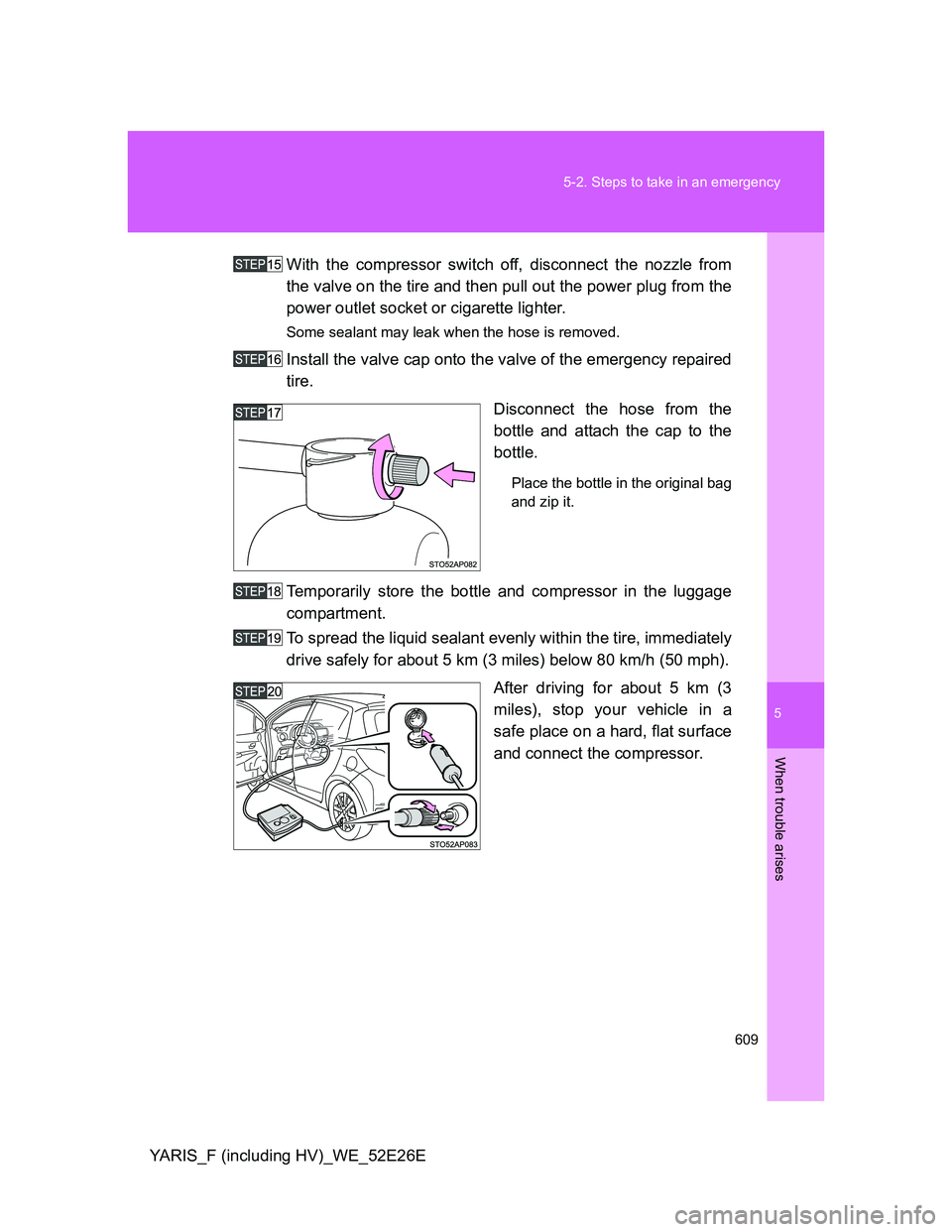
5
609 5-2. Steps to take in an emergency
When trouble arises
YARIS_F (including HV)_WE_52E26EWith the compressor switch off, disconnect the nozzle from
the valve on the tire and then pull out the power plug from the
power outlet socket or cigarette lighter.
Some sealant may leak when the hose is removed.
Install the valve cap onto the valve of the emergency repaired
tire.
Disconnect the hose from the
bottle and attach the cap to the
bottle.
Place the bottle in the original bag
and zip it.
Temporarily store the bottle and compressor in the luggage
compartment.
To spread the liquid sealant evenly within the tire, immediately
drive safely for about 5 km (3 miles) below 80 km/h (50 mph).
After driving for about 5 km (3
miles), stop your vehicle in a
safe place on a hard, flat surface
and connect the compressor.
Page 610 of 712
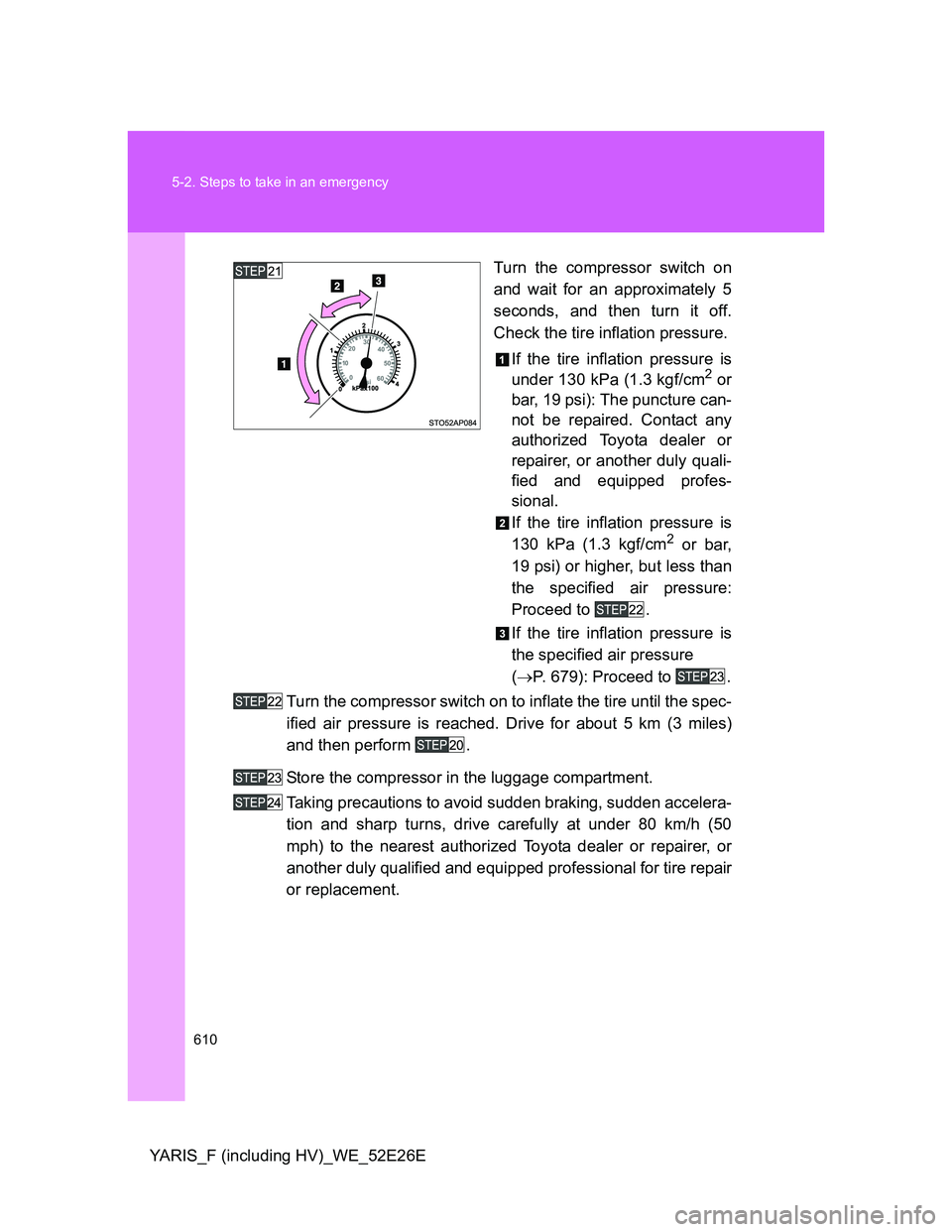
610 5-2. Steps to take in an emergency
YARIS_F (including HV)_WE_52E26ETurn the compressor switch on
and wait for an approximately 5
seconds, and then turn it off.
Check the tire inflation pressure.
If the tire inflation pressure is
under 130 kPa (1.3 kgf/cm
2 or
bar, 19 psi): The puncture can-
not be repaired. Contact any
authorized Toyota dealer or
repairer, or another duly quali-
fied and equipped profes-
sional.
If the tire inflation pressure is
130 kPa (1.3 kgf/cm
2 or bar,
19 psi) or higher, but less than
the specified air pressure:
Proceed to .
If the tire inflation pressure is
the specified air pressure
(P. 679): Proceed to .
Turn the compressor switch on to inflate the tire until the spec-
ified air pressure is reached. Drive for about 5 km (3 miles)
and then perform .
Store the compressor in the luggage compartment.
Taking precautions to avoid sudden braking, sudden accelera-
tion and sharp turns, drive carefully at under 80 km/h (50
mph) to the nearest authorized Toyota dealer or repairer, or
another duly qualified and equipped professional for tire repair
or replacement.